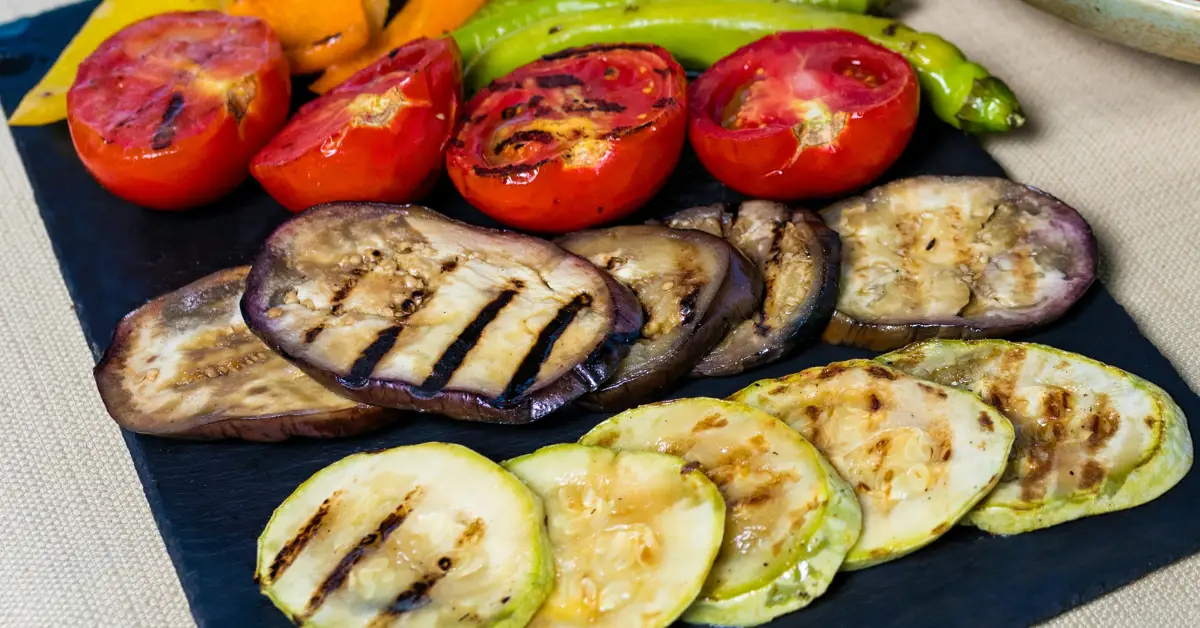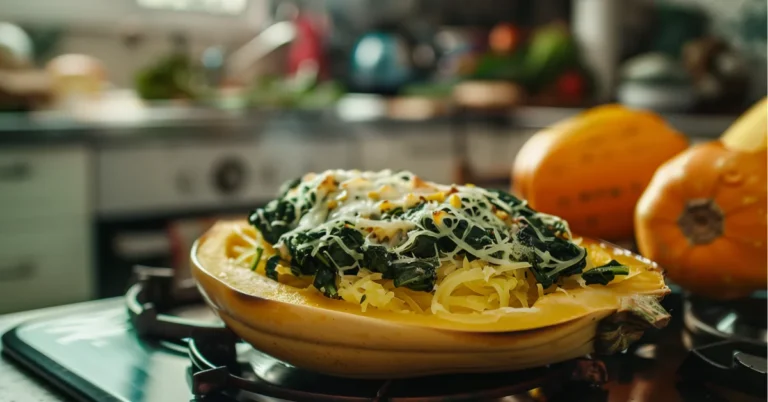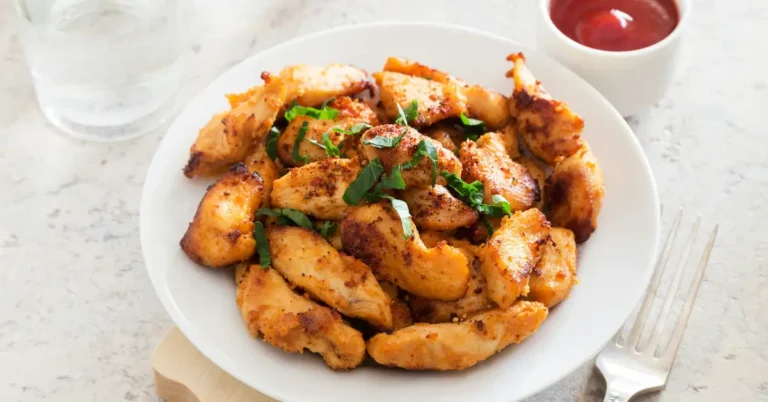I can’t resist the sizzle and aroma of low carb roasted vegetables fresh from the oven. Their crispy edges and caramelized, slightly sweet flavors are a healthy delight I look forward to. The fact that roasting can transform even the most humble veggies into a mouth-watering side dish makes it a fantastic method for anyone following a low-carb lifestyle.
Exploring a variety of spice combinations and fresh herbs is part of the fun, turning my kitchen into a playground of tantalizing flavors. My plate ends up a canvas of vibrant greens, reds, and yellows, each bite a reminder that eating well doesn’t have to be boring. It brings me joy to discover that something as simple as low carb roasted vegetables can offer such complex textures and tastes, perfect for any meal or occasion.
Benefits of Low Carb Roasted Vegetables
I adore the way low carb roasted vegetables complement my meals by offering not only a burst of flavor but also a powerhouse of nutritional benefits! When I toss my veggies in the oven to roast, I know I’m creating something wonderful for my health. What’s not to love?
Firstly, the reduced carbohydrate content makes them an ideal choice for my low carb lifestyle. My go-to options like Brussels sprouts, bell peppers, and cauliflower florets are both delicious and nutritious without the worry of overloading on carbs.
I’m also getting a fabulous fiber boost! Roasting vegetables retains a lot of their fiber content, which is fantastic for my digestive health. Plus, fiber keeps me feeling full longer, which is a great way to resist those pesky cravings.
As for vitamins and minerals, these vegetables are little heroes. They provide my body with essential nutrients like vitamin C, potassium, and folate. When I roast vegetables, they develop a caramelized, sweet flavor that’s irresistible, and I don’t even need to add much oil or seasoning. This means they remain low in calories and high in taste.
Here’s a quick tally of their perks:
- Low in Carbs: Perfect for my low carb diet.
- High in Fiber: Keeps me full and my digestion in check.
- Rich in Nutrients: They’re chock-full of vitamins and minerals.
- Natural Flavor: Roasting brings out a wonderful depth of flavor.
- Versatile: I can mix and match to suit my taste buds and nutritional needs.
Choosing Vegetables for Roasting

When I’m in the kitchen, ready to churn out a healthy and flavorful side dish, choosing the right vegetables for roasting is a thrilling first step. It’s all about picking veggies that provide maximum taste while aligning with a low-carb lifestyle.
Low Carb Vegetable Options
Here are some of my top picks for low carb roasted vegetables that transform beautifully in the oven:
- Broccoli & Cauliflower: Infamous for their adaptability and carb-friendly nature.
- Zucchini & Squash: Their water content helps them roast up tender and delicious.
- Bell Peppers: A splash of color with a sweet, roasted finish.
- Green Beans: They become wonderfully crisp and retain a bright, fresh flavor.
- Asparagus: Tall, slender, and elegant with a satisfying crunch.
Seasonal Vegetable Selection
I always look forward to the seasonal shifts that bring about different roasting options:
- Spring: Asparagus and radishes offer fresh, earthy delights.
- Summer: Nothing beats the vibrant flavors of peppers and squashes.
- Autumn: This is the time for brussels sprouts and pumpkins to shine.
- Winter: Root vegetables like turnips and rutabagas, lower in carbs, become stars.
By choosing low carb roasted vegetables that are in season, I ensure the freshest, most flavorful dish possible.
Preparation Techniques
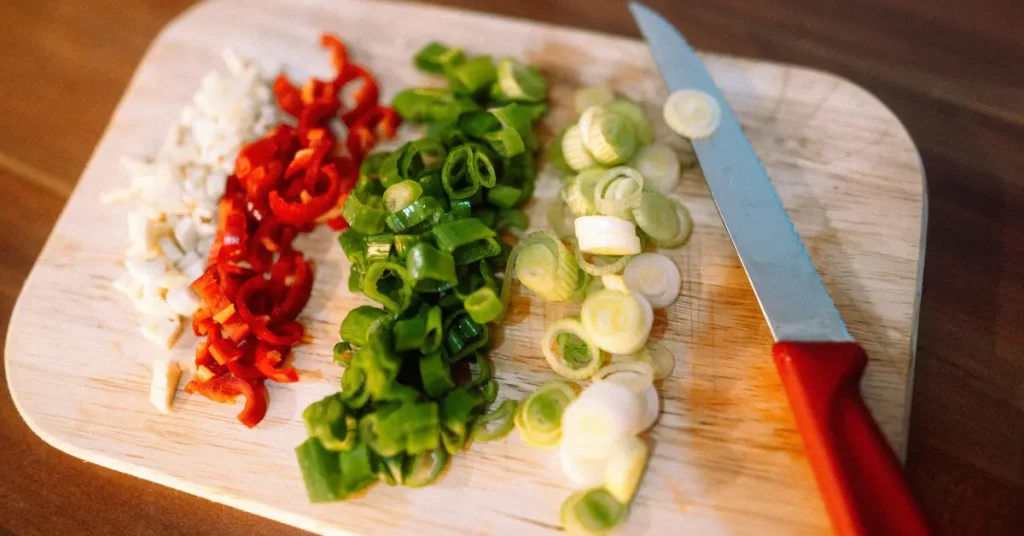
Before I dive into the nitty-gritty, let’s focus on two essential steps that’ll make your low carb roasted vegetables burst with flavor and perfect texture: proper washing and cutting, and my go-to seasoning strategies.
Washing and Cutting
When I get my hands on fresh vegetables, I always make sure they’re washed thoroughly to remove any dirt or chemicals. I pat them dry because water can affect how they roast, leading to steaming instead of that delightful caramelization. Cutting the veggies is an art on its own; I aim for uniform pieces to ensure they all cook evenly. Here’s how I do it:
- Root vegetables (like turnips and radishes): I peel them if needed, and chop them into bite-sized cubes, about 1/2 inch thick.
- Cruciferous vegetables (like broccoli and cauliflower): I trim the stems and cut them into similar-sized florets to promote uniform cooking.
Seasoning Strategies
The right seasoning can transform roasted vegetables from good to wow! I’ve learned to go beyond salt and pepper, exploring herbs and spices that complement a low carb lifestyle. Check out my favorite blends:
- Oils: Extra virgin olive oil or avocado oil for their health benefits and high smoke points.
- Herbs: Dried Italian seasoning or a mix of thyme, rosemary, and oregano to add a classic touch.
- Spices: A sprinkle of garlic powder, a pinch of sea salt, and a dash of black pepper for that kick.
- Acidity: A light drizzle of balsamic vinegar or a squeeze of lemon juice for a bright finish.
Each vegetable is a canvas, and with these seasoning tips, I can truly make them shine. If you’re looking for inspiration, the combinations of oils and spices suggested can be a great place to start for creating a delicious medley that complements any low carb diet.
Roasting Methods

In my kitchen, roasting vegetables isn’t just a cooking technique, it’s an art form that transforms humble veggies into culinary masterpieces. Let’s dive into the specific methods I use to achieve that perfect golden crisp.
Oven Roasting
I preheat my oven to around 400-450 degrees F, which is ideal for getting that delicious caramelization on the veggies. Chop the vegetables to a uniform size for even cooking.
Air Frying
When I air fry my vegetables, I aim for a lower temperature, about 375 degrees F. This ensures they cook quickly while achieving a good outer crunch. The avocado oil’s high smoke point makes it perfect for this method. No need to preheat; just toss in the veggies, and give them a shake halfway through cooking.
Grilling
Grilling vegetables on a BBQ gives them an irresistible smoky flavor and makes them an unbeatable BBQ Side Dish for a low carb diet. I make sure the grill is hot and the veggies are sliced thickly enough to not fall through the grates. Sometimes I’ll wrap them in foil with a dash of olive oil and seasonings — it’s a fantastic way to infuse them with an extra layer of taste.
You can also use a Blackstone griddle, that’s a versatile gadget for cooking all different kinds of foods.
Flavor Enhancements

I always get excited about taking my low carb roasted vegetables to the next level! Picking the right herbs, spices, marinades, and dressings can transform any low-carb veggie dish into a culinary masterpiece.
Herbs and Spices
My go-to tactic for boosting flavors is to reach for herbs and spices. Here’s a quick cheat sheet I swear by:
- Garlic Powder: It’s a classic, and adds a warm and savory touch.
- Italian Seasoning: This blend is a wonderful combo of basil, oregano, and other Mediterranean herbs.
- Cayenne Pepper: Just a pinch can induce a pleasant heat.
- Sea Salt and Black Pepper: The essential duo that should never be neglected.
I’m inclined to recommend trying rosemary or thyme for heartier vegetables like rutabaga and radishes.
Marinades and Dressings
I love tossing my veggies in a tantalizing marinade before roasting them! Here’s my flavor-packed formula:
- Olive Oil: The perfect base for any dressing.
- Balsamic Vinegar: Adds depth and a hint of sweetness.
- Honey Mustard: Elevates the mix with a tangy kick.
When I learned how a simple whisk of olive oil, vinegar, and seasoning could amplify my veggies, it was a game-changer!
If you are short on time, then you can try out one of the best keto dressings I researched.
Serving Suggestions
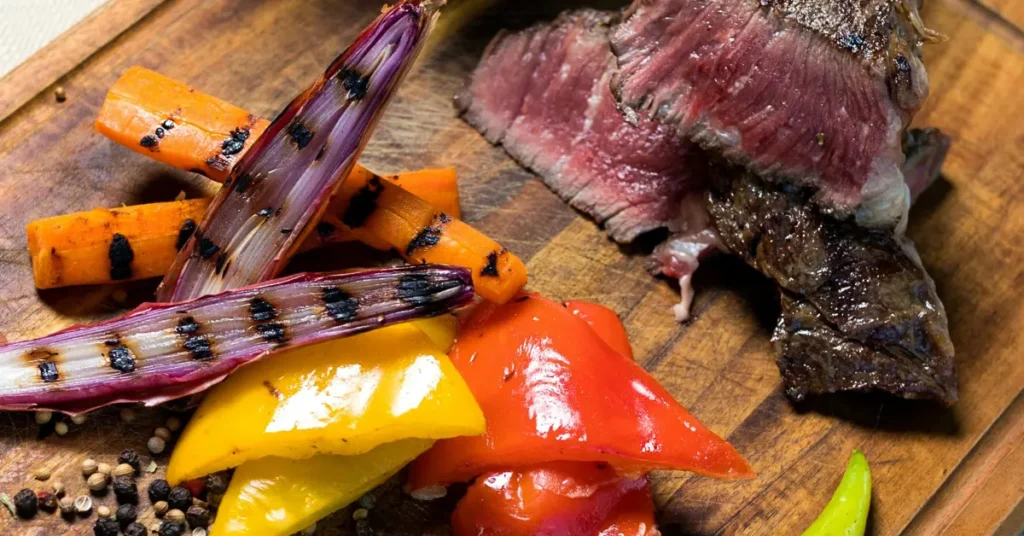
I absolutely love mixing up my meals with low carb roasted vegetables! They’re so versatile and delicious. Here are some fabulous ways I pair them up for a satisfying, hearty meal:
- Pair With Proteins: Roasted veggies are perfect alongside a juicy steak, grilled or canned chicken, or seared fish. The smoky flavor complements the richness of the meat beautifully.
- Eggcellent Breakfast: In the morning, I toss a handful of these veggies with scrambled eggs for a filling, keto-friendly start to the day.
- Salad Topping: I sometimes use them cold, adding a crunch to my leafy greens. A sprinkle of crumbled feta or goat cheese takes it to the next level!
My Go-To Combos:
- Rutabaga & Bacon: The sweetness of rutabaga pairs wonderfully with the saltiness of bacon.
- Brussels Sprouts & Parmesan: I finish them with a generous dusting of parmesan for an irresistible dish.
- Brokkolli & Ham: Adding ham creates a delicious and high-protein combination.
Here’s a quick table for flavor pairing ideas:
| Vegetable | Seasoning | Perfect For |
|---|---|---|
| Zucchini | Italian Herbs | Italian dishes |
| Broccoli | Garlic & Lemon Zest | Zesty sides |
| Bell Peppers | Cajun Spices | A spicy kick |
Nutritional Insights
I’m thrilled to dive into the nutritional profile of low carb roasted vegetables, which are not just a delight for the taste buds but also a powerhouse of nutrients!
Macronutrient Breakdown
When I roast my selection of low-carb veggies, I’m looking at a dish that’s typically high in fiber and rich in other nutrients while being low in carbohydrates. For instance, by including vegetables like broccoli and Brussels sprouts, I ensure my dish is packed with fiber and protein but remains low in carbs. This combination helps keep my blood sugar levels stable and supports satiety.
- Fiber: Essential for digestive health and can vary from 2 to 4 grams per cup of vegetables.
- Protein: Roughly 2 to 3 grams per serving, depending on the veggies chosen.
- Carbohydrates: Approximately 5 to 10 grams per cup, with variations based on the specific vegetables used.
Vitamin and Mineral Content
One of the things I love most about low carb roasted vegetables is their vitamin and mineral content. Roasting vegetables like zucchini and bell peppers enhances their natural flavors and preserves most of their nutritional value. These vegetables provide an array of essential nutrients, such as:
- Vitamin C: A strong antioxidant, crucial for immune function.
- Vitamin K: Important for bone health.
- Potassium: Helps in regulating blood pressure.
Each serving of roasted vegetables can be a significant source of these nutrients, contributing to overall health and well-being.
Recipe Ideas
I can’t wait to share these fabulous low carb roasted vegetable ideas that’ll spice up any meal, whether it’s a casual dinner or a fancy celebration! Picking the right vegetables and flavors can turn even simple dishes into star entrées or sides. Here’s how I do it:
Casual Dinners
For a relaxed weekday meal, nothing beats the simplicity of mixed roasted vegetables with a drizzle of olive oil. I’ll usually go for a blend that includes brussels sprouts, zucchini, and red onions as they caramelize beautifully and pair well with a pinch of sea salt and Italian herbs. Sometimes, I add a splash of balsamic vinegar for a hint of tangy sweetness. These low carb choices make for a satisfying side without any fuss.
For a different twist, I’ll toss rutabaga, leeks, and turnips with some olive oil, rosemary, and thyme. The earthy tones of these root vegetables are perfect for grounding a meal that both comforts and satisfies.
Special Occasions
When I’m entertaining or celebrating a special event, I elevate my low carb vegetable game. I might opt for a colorful medley of yellow and red bell peppers, known for enhancing each other’s flavors when roasted, along with some squash for texture. Adding a touch of class to these veggies can be as simple as a sprinkle of Lakanto Monkfruit Classic to balance the natural acidity. This combination not only tastes luxurious but also looks gorgeous on a plate.
For another celebratory side, I adore keto-friendly options like roasted asparagus with parmesan cheese or cauliflower with a blend of curry spices. They’re low in carbs but high on flavor, making them a sophisticated choice that’ll impress my guests. Plus, they’re so vibrant and flavorful that no one will ever guess they’re healthy too!
FAQ
What are low carb roasted vegetables?
Low carb roasted vegetables are veggies cooked in an oven with minimal added fats or oils. They’re a nutritious option for those following a low-carbohydrate diet, as they contain fewer carbs compared to traditional roasted vegetables.
Which vegetables are best for low carb roasting?
Non-starchy vegetables like broccoli, cauliflower, zucchini, bell peppers, and Brussels sprouts are excellent choices. These veggies are low in carbohydrates while being rich in vitamins, minerals, and fiber.
How do I roast vegetables without adding too many carbs?
To keep carbs low, use minimal oil or opt for healthier fats like olive oil. Season with herbs and spices instead of sugary marinades. Watch portion sizes and avoid high-carb vegetables.
If you liked this blog post about the topic: Low Carb Roasted Vegetables, don’t forget to leave us a comment down below to tell us about your experience with it. And don’t forget to follow us on Pinterest so you don’t miss any more Diet and Nutrition content.

